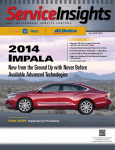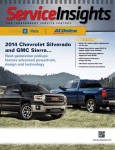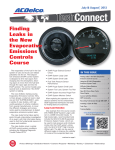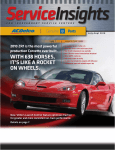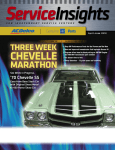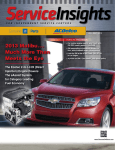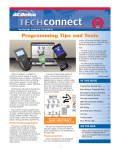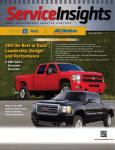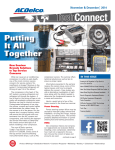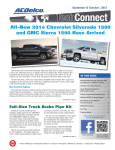Download Buick 2001 Park Avenue Specifications
Transcript
January & February 2012 Battery Killers Common Causes of Battery Failure Hot or cold, a harsh environment has a negative effect on automotive battery life. Slow cranking, especially during colder weather at this time of year, is often the first sign of a failing battery. IN THIS ISSUE The battery has three functions as a major source of energy: Battery Killers . . . . . . . . . . . . . . . . . . . . . . . .1 • Engine cranking OnStar Back-up Battery Activation . . . . .3 • Voltage stabilizer Duramax Diesel Exhaust System Fluid Injectors . . . . . . . . . . . . . . . . .4 • Alternate source of energy with generator overload When replacing a battery, the new battery should match the specifications of the original battery in order to maintain proper vehicle performance. New Advanced Powertrain Technology Seminar . . . . . . . . . . . . . . . . . .5 Battery Ratings 2012 TSS Program Changes . . . . . . . . . . . .6 First 2012 ASE Computer-Based Testing Session . . . . . . . . . . . . . . . . . . . . . .6 A battery may have three ratings: amperage hours (AH), reserve capacity (RC), and cold cranking amperage (CCA). Tech Tips . . . . . . . . . . . . . . . . . . . . . . . . . . . .7 The amperage hour rating is the amount of time it takes a fully charged battery, being discharged at a constant rate of 1 amperes and a constant temperature of 80° F (27° C), to reach a terminal voltage of 10.5 volts. 10.5 V is the fully discharged level, at which point the battery needs to be recharged. Training Update . . . . . . . . . . . . . . . . . . . . . .8 ON THE WEB Reserve capacity is the amount of time in minutes it takes a fully charged battery, being discharged at a constant rate of 25 amperes and a constant temperature of 80° F (27° C), to reach a terminal voltage of 10.5 volts The cold cranking amperage is an indication of the ability of the battery to crank the engine at cold temperatures. The cold cranking amperage rating is the minimum continued on page 2 – www.acdelcotechconnect.com, click the TechConnect Magazine link, or – Log in to the ACDelco LMS, click the Resources link Battery Killers – continued from page 1 amperage the battery must maintain for 30 seconds at 0° F (−18° C) while maintaining at least 7.2 V. Volume 19, Number 1 (TS-PU-0005-12) Electrolyte Freezing A typical automotive battery is a flooded cell lead-acid battery. It is formed when two chemically dissimilar plates, divided by a separator, are placed in a solution called electrolyte. In automotive batteries, one plate is made of lead and the other of lead dioxide. The electrolyte is a solution of 64% water and 36% sulfuric acid. A The chemical composition of the electrolyte chemical reaction occurs between the changes as the battery is discharged. two plates and electrolyte solution that create approximately 2.1 volts of electrical energy. As a battery loses its charge, the chemical composition of the electrolyte changes and it becomes more like water. The freezing point of electrolyte depends on its specific gravity. A fully charged battery will not freeze until the ambient temperature gets below −65° F (−54° C). However, a battery with a low state of charge may freeze at temperatures as high as 20° F (−7° C). Since freezing may ruin a battery, the battery should be protected against freezing by keeping it properly charged above 80 percent state of charge, where the freezing point of the battery will be somewhere below −25° F (−32° C). Common Causes of Malfunction Regardless of the environment, a battery is not designed to last forever. With proper care, however, the battery will provide years of good service. If the battery tests “good” but still fails to perform well, check for these common causes: • Vehicle accessories left on after the ignition is turned off • Regular short trips in stop-and-go traffic, and with many electrical accessories in use, such as the air conditioning, headlights, wipers, rear window defroster, etc., that do not allow enough time to properly charge the battery • The electrical load has exceeded the generator output, particularly with the addition of aftermarket equipment • Existing charging system conditions, such as a slipping belt or a generator that is not in proper working order • The battery has not been properly maintained, including a loose battery hold down or missing battery insulator • Electrical system conditions that draw down battery power Parasitic Draw Components most likely to cause a parasitic draw on a vehicle’s battery are switches, relays and control modules. After the ignition is turned off, the control modules will begin to go to sleep (shut off). All control modules do not go to sleep at the same time; some may take up to 30 minutes or longer after turning off the ignition before going to sleep, like the Body Control Module (BCM). Others modules are designed to periodically wake up, perform a task, and go back asleep at regular intervals, such as the OnStar and keyless entry control modules. These are all normal conditions. For example, an engine off natural vacuum evaporative test can occur if the Engine Control Module (ECM) determines the drive cycle has met the appropriate criteria immediately after key off. The ECM will stay awake and the vent solenoid will stay energized for as long as 45 minutes. The typical current draw for this is about 1 A. The remote keyless entry receiver also consumes an extremely low mA current for monitoring purposes. Actual system wake up only occurs when the key fobs for the vehicle are used. When other devices on the same remote keyless entry continued on page 3 2 ACDelco TechConnect is published bi-monthly and online for technicians of Total Service Support (TSS) and Key Fleet accounts to provide timely service information, increase knowledge and improve the performance of the service center. ACDelco 360 represents our mission to look at our businesses at every possible angle to provide value and assistance to our distributors and their customers as well as offer a full circle of support with programs, tools, training and marketing focused on enhancing and growing our partnership successfully. Publisher: Rick Balabon ACDelco E-mail / [email protected] Editor: Greg St. Aubin ACDelco E-mail / [email protected] Technical Editor: Mark Spencer E-mail / [email protected] Production Manager: Marie Meredith Desktop Publishing: 5by5 Design LLC E-mail / [email protected] Write to: * ACDelco TechConnect P.O. Box 500 Troy, MI 48007-0500 On the Web:: To read and search recent issues of TechConnect online: – www.acdelcotechconnect.com, click the TechConnect Magazine link, or – Log in to the ACDelco LMS, click the Resources link ACDelco service tips are intended for use by professional technicians, not a “do-it-yourselfer.” They are written to inform those technicians of conditions that may occur on some vehicles, or to provide information that could assist in the proper service of a vehicle. Properly trained technicians have the equipment, tools, safety instructions and know-how to do a job properly and safely. If a condition is described, it cannot be assumed that the information applies to all vehicles or that all vehicles will have that condition. All materials and programs described in this magazine are subject to change. Submission of materials implies the right to edit and publish. Inclusion in the publication is not necessarily an endorsement of the individual or the company. TechConnect is published for ACDelco by Sandy Corporation, Troy, MI. ©2012 ACDelco. All rights reserved. Battery Killers – continued from page 2 operating frequency are activated, the receiver will have a 100 mA spike. These spikes are normal and should not cause excessive battery draw. Check any possible aftermarket equipment that may cause an unacceptable parasitic current drain. Aftermarket accessories installed into the courtesy lamp circuit can cause the inadvertent power timer in the BCM to keep resetting, which could cause the BCM to remain awake and cause a current drain on the battery. Battery Testing using a Conductance Tester Conductance is a measurement of a battery’s current producing capability. This technology can help accurately identify batteries that have reduced performance after being in service. When using a conductance-type battery tester on side terminal and top stud batteries: • Make sure the battery in the tester is not weak or inaccurate readings may result • When testing side terminal or top stud batteries with a conductance tester, always use lead terminal adapters. Make sure the terminal adapter makes good contact with the lead pad of the battery or inaccurate readings will result • Never clamp the tester's leads directly to the studs when testing a top stud battery with a conductance tester • ACDelco ST-1201 side terminal/top stud adapters are for the charging and load testing of batteries only. They should not be used when testing a side terminal or top stud battery with a conductance tester. Inaccurate readings will result due to the coating on the ST-1201 adapters Conductance-type battery testers should never be used to determine state of health, state of charge, or CCA rating of a new, never installed battery. New batteries will develop their full performance capabilities only after a period of cycling in a vehicle. To check the condition of a battery prior to installation, measure open circuit voltage (OCV). An OCV of 12.24V is adequate to provide the power requirements for starting most vehicles under most conditions. All batteries will self-discharge and deteriorate in condition over time, which makes proper rotation and proper storage — a battery stored at 95° F (35° C) will self-discharge twice as fast than one stored at 75° F (23.9° C) — of inventory essential. – Thanks to Todd Merkel • Never use steel bolts when testing a side terminal battery with a conductance tester OnStar Back-up Battery Activation During diagnosis of an electrical condition, such as a battery parasitic drain, it’s important to understand the power consumption and activation of the OnStar® system. The system also features a back-up battery that is designed to activate only when the main battery power is lost. The OnStar system will stay powered up after the ignition has been turned off for an extended time in order to allow for remote services such as door unlock, horn chirp, light flash, etc. Power cycle (also referred to as DRX) times vary depending on the generation of the OnStar system. The system generation can be identified by using a Tech 2 scan tool (Body> Vehicle Communication Interface Module>Module ID Information> Module Information 2) or GDS/GDS 2 (Telematics Communication Interface Control Module/Identification Information). All Gen 6, 7, 8, and 9 systems are powered up continuously for 48 hours from ignition off. After 48 hours, the Gen 6 and some Gen 7 systems power off; Gen 7.XXL and all Gen 8 systems will enter a 9 minute OFF/1 minute ON power cycle for an additional 72 hours. Gen 9 and FCP1 (Chevy Volt) will remain in this mode for 120 hours (5 days). After 120 hours from ignition off, these systems completely power off. The expected current draw of the OnStar module is: • IGN ON – 240 to 400 mA • IGN OFF – 3 to 20 mA for 48 hours or 120 hours on Gen 9, FCP1 (Volt), and specified VCPs • IGN OFF – 0.2 to 0.8 mA after 48 hours or 120 hours on Gen 9, FCP1 (Volt), and specified VCPs Certain OnStar-equipped vehicles may also be equipped with a back-up battery. The back-up battery is a nonrechargeable, lithium battery intended to provide an auxiliary power source for the Telematics Communication Interface Control Module, or Vehicle Communication Interface Module (VCIM), so an emergency notification call can be made in the event of a vehicle collision where power from the main vehicle battery is disabled. If the back-up battery fails, a Diagnostic Trouble Code may set. Do not disconnect the main vehicle battery or remove the Telematics Communication Interface Control 3 Module fuse with the ignition key in any position other than OFF. Disconnecting power to the Telematics Communication Interface Control Module in any way while the ignition is ON or with Retained Accessory Power (RAP) activated may cause activation of the OnStar back-up battery. Opening the driver’s door should disable RAP. Once the back-up battery is activated, it will stay on until it has completely discharged. The backup battery is not rechargeable and once activated it must be replaced. The back-up battery is intended to have a limited life span of approximately four years and is designed to maintain an open circuit voltage between 16V and 9V throughout this period. The back-up battery is connected to the control module through the back-up battery positive voltage circuit and back-up battery ground circuit and is protected from a short circuit by means of an internal fuse. The status of the back-up battery and its associated wiring is monitored by the Telematics Communication Interface Control Module. – Thanks to Rick Balabon Duramax Diesel Exhaust System Fluid Injectors The new 6.6L Duramax diesel engine that debuted in the 2010 Chevrolet Express and GMC Savana and 2011 Chevrolet Silverado and GMC Sierra is equipped with an advanced exhaust aftertreatment system to reduce emissions. The aftertreatment system features two diesel exhaust system injectors. The Diesel Exhaust Aftertreatment Fuel Injector, also called the Q57 Indirect Fuel Injector or the Hydrocarbon Injector, supports Diesel Particulate Filter (DPF) regeneration — reducing particulate matter, or soot, in the exhaust — by adding fuel to the engine exhaust system. On the previous Duramax diesel engine, this was accomplished using the cylinder injectors via post injection. Now, the Exhaust Aftertreatment Fuel Injector sprays fuel into the turbo downpipe. The other new injector is the Diesel Emission Reduction Fluid Injector, also called the Diesel Exhaust Fluid (DEF) injector. It injects DEF into the exhaust gases to suppress oxides of nitrogen (NOx) emissions. The DEF injector is located downstream of the Diesel Oxidation Catalyst (DOC) and upstream of the Selective Catalyst Reduction (SCR) system/DPF. Diesel Exhaust Aftertreatment Fuel Injector The Diesel Exhaust Aftertreatment Fuel Injector, or Hydrocarbon Injector (HCI), is a new type of dedicated diesel fuel injector used during DPF regenerations only. The fuel injector threads into the turbo downpipe tube. The HCI is commanded on by the Engine Control Module (ECM) and injects fuel directly into the engine’s exhaust gases downstream of the engine’s turbo. Fuel to the injector is supplied from the low-pressure side of the high-pressure fuel pump. The injector’s control valve is located over the right rear cylinder head. The HCI supplies a measured quantity of fuel into the exhaust gas only during enabled regeneration events. The DOC converts this added fuel into the heat that’s needed to regenerate the DPF by incinerating accumulated soot. DOC temperatures are monitored during regeneration by two Exhaust Gas Temperature sensors (EGT 1 and EGT 2). If temperatures are too low, DTC P0420 (Catalyst System Low Efficiency) will set. The HCI system operates only when enabled (regen enable). On 2010- 2011 model year vehicles, the system isn’t used during service regenerations. The service regeneration cycle is driven by post-injection from the engine’s eight diesel fuel injectors (just as on the 2007-2010 Duramax engine). For 2012, the HCI system is used for both enabled and service regenerations. Diagnosis Successful on-road DPF regeneration relies on proper HCI function. For Duramax diesel DTCs such as P0420, P24A0 (Closed Loop DPF Regeneration Control at Limit - Temperature Too Low), or P2463 (Diesel Particulate Filter Soot Level Accumulation), the indirect fuel injector should be diagnosed for proper function as described in the appropriate Service Information. Test the HCI for proper flow quantity prior to replacing the DOC to avoid misdiagnosis. When servicing the DEF tank and DEF injector, do not overstress the DEF injector’s plastic inlet nipple. Make sure the emission reduction fluid exhaust supply pipe retains slack. The nipple can fracture if overstressed. When removing the DEF supply pipe from the DEF injector, it may be necessary to flush the connector with water to ease release of the supply pipe from the injector nipple. Diesel Exhaust Fluid DEF (urea) is a clear solution of approximately 32% ammonia and 68% water. When the water evaporates from the fluid, white crystalline deposits (some deposits may appear darker depending on soot incorporation) of urea remain. Since this fluid travels through the DEF injector, it is common for these deposits to form at the exit nozzle of the injector and, in some cases, inside the injector. If the HCI isn’t injecting enough fuel, the regeneration-measured exhaust temperatures (as determined by EGT 1 and 2) may be too low and set DTC P0420. Prolonged HCI difficulty may also set DTC P2463 or P2459 (Diesel Particulate Filter Regeneration Too Often). Diesel Emission Reduction Fluid Injector The Diesel Emission Reduction Fluid Injector, or Diesel Exhaust Fluid (DEF) injector, sprays DEF into the exhaust for distribution into the SCR catalyst. The DEF injector is mounted just downstream of the DOC canister on the DOC exhaust pipe. To help maintain DEF injector integrity, let the vehicle idle for 10 minutes immediately after a service regeneration before turning off the engine. This allows time for the DEF injector to cool. Crystalline urea deposits over the DEF injector’s exit nozzle. The presence of deposits over the DEF injector’s exit nozzle alone shouldn’t prompt an injector replacement. Rather, perform the DEF Quantity Test — refer to the Emission Reduction Fluid Injector Quantity Test in the Service Information — to diagnose the DEF injector for performance issues. The urea deposits are usually soluble in water. Once the DEF system begins spraying fluid again, these deposits dissolve and clear from the nozzle exit. This includes the crystals that may form on the inside of the DEF injector as well as at the exit nozzle. If these deposits interfere with DEF injection, perform the quantity test a few times to allow for the DEF crystals to dissolve. The DEF injector is mounted downstream of the DOC canister on the DOC exhaust pipe. continued on page 5 4 New Advanced Powertrain Technology Seminar Driving one mile in a Chevrolet Volt running on electricity is estimated to cost about one-sixth of what it costs to drive a conventional gasoline vehicle, when charged at off-peak hours. That means for the same cost of driving 30 miles on electricity in a Volt, you’ll only get five miles using gasoline. Doing the math highlights one of the reasons behind the development of electrified powertrains such as the Volt and the new GM eAssist system, which offer an alternative to higher fuel prices as well as an opportunity to reduce the amount of carbon dioxide emitted into the environment. The new ACDelco Advanced Powertrain Technology seminar, S-EL06-06.01SEM, is a one-hour seminar providing an overview of GM electric and eAssist hybrid vehicles, including electrical power supply systems, high voltage systems, eAssist operation, Jump Assist and jump starting procedures. The different types of hybrid vehicles are reviewed in the seminar. These include series hybrid electric vehicles, such as the Volt, where only the electric motors propel the vehicle; parallel hybrid electric vehicles, such as the Buick Regal with eAssist, where the power of the electric motor assists the internal combustion engine; and series/parallel hybrid electric vehicles, such as the Chevrolet Tahoe Two-Mode SUV, which allows direct connection of both the engine and the electric motors to the final drive. Volt Electric Drive System The seminar covers the high-torque electric drive system of the Volt. Energy is stored in the 16-kilowatt (kW) hours lithium ion battery pack that has three battery cell sections connected in series to produce a nominal 360 volts. High voltage system components, including the drive motor battery charger and the drive motor/generator power inverter module, also are presented. The seminar covers: • Safety considerations • Hybrid vehicle types • Chevrolet Volt high voltage electrical energy source • eAssist components • eAssist drive cycle • Jump starting procedures integrated in the powertrain to provide electric boost as well as restart the engine after automatically turning off when stopped. The seminar highlights the various eAssist system components, such as the 15kW that provides up to 15 kW of electrical energy as a generator and 44 lb.-ft. of torque as a motor. In addition, the seminar covers how the Jump Assist feature of the eAssist system works. The Jump Assist feature supplies electrical energy from the high voltage battery to the 12V battery to jump start the vehicle. Learn More • The benefits of electrified powertrains • Chevrolet Volt electric drive system operation eAssist motor/generator Volt lithium ion battery pack eAssist System The eAssist system now offered in the new Buick LaCrosse and Buick Regal features a motor/generator that is In addition to the new Advanced Powertrain Technology seminar, ACDelco offers Web-based training courses, online Virtual Classroom Training and a variety of instructor-led, hands-on courses. To review the latest training courses available, log in to the ACDelco Learning Management System (LMS) at www.acdelcotraining.com. To learn when ACDelco seminars will be scheduled in your area, contact your local ACDelco distributor. – Thanks to Greg St. Aubin Duramax Diesel Exhaust System Fluid Injectors – continued from page 4 Temperature also helps dissolve the crystals deposits. Urea melts at about 135°C. Since the quantity test is performed when the vehicle is off, it may take longer for the crystals to dissolve than it would on a running vehicle. Cold Temperatures When the 6.6L Duramax diesel engine is operated in extremely cold ambient temperatures, a Service Exhaust Fluid System message may be displayed on the Driver Information Center. DTC P204F (Reductant System Performance), may set with possible vehicle speed limiting. Temperatures would have to be under -4° F (-20° C) for long periods of time. If this message is displayed, complete the current Service Information diagnosis for any DTCs or symptoms found. The vehicle may actually have a low reductant fluid pressure, which would also set DTC P204F. For 2010-2011 models only, a new calibration was released to improve extreme cold temperature conditions related to DTC P204F. 2012 models have updated calibrations. 5 Other factors that could contribute to the setting of DTC P204F include the use of an aftermarket winter cover or a combination of a winter cover and a snow plow (if the vehicle is equipped with a snow plow, a winter cover must not be used). This may allow the system to sense artificially high underhood temperatures, which could potentially prevent the DEF heaters from turning on and thawing the reductant fluid as required. – Thanks to Brian Fuller and B.J. Lackey PSC 2012 TSS Program Changes In 2011, ACDelco worked closely with many of our DDG and Total Service Support (TSS) partners to review the TSS program. Based on that feedback, ACDelco has added some great new benefits and enhanced many others. The key changes are listed below. Program Name Change The TSS Program will become the ACDelco Professional Service Center program. This change creates a more consumer friendly image that combines the dedication of all program members with the strength of the ACDelco brand. ACDelco Reward Points purchases of ACDelco parts. In addition, there will be an expanded usage of points for all levels. Consumer Assurance Enhancements Labor Reimbursement for eligible ACDelco product failures when the customer returns to the original repair facility. Available to White and Blue level accounts. Roadside Assistance is available to all Professional Service Center customers, provided they have a paid invoice, regardless of the brand of part installed. Customizable ACDelco.com Locator Landing Pages Customization - Photos and extra content can be added to the listing information provided online to customers looking for repair facilities. Available to White and Blue level accounts. Blue level accounts also can add a link to their shop’s website. For more information about the changes to the new ACDelco Professional Service Center Program, contact your ACDelco representative. – Thanks to Laura Rollinger Professional Service Center Program Benefits Summary ACDelco Reward earnings now start at dollar one ($1,000 qualifier has been removed) for all levels. Program participants can receive up to five percent back on all reported monthly First 2012 ASE Computer-Based Testing Session Beginning in 2012, the National Institute for Automotive Service Excellence (ASE) will offer all ASE certification tests only in the ComputerBased Testing (CBT) format. Test sessions are available in two-month windows, four times each year, starting with the first testing sessions in January-February 2012. The Winter 2012 CBT dates are: Registration: January 10 – February 20 Testing: January 17 – February 29 CBTs offer test takers advantages in scheduling, convenience, and speed over the written tests. More testing session All ASE certification tests are now in the Computer-Based Testing format. choices will be available when reserving an appointment. Plus, when completing a CBT, test takers will receive their test results before leaving the test center. 6 The ASE computer-based certification tests will not be available to be completed online at home or at work. The tests are only offered in secure, proctored test centers in order to give everyone a fair, consistent, and reliable testing environment, where the identity of each person taking a test is also verified. There are currently more than 300 testing site locations. Visit www.ase.com for more information on the new enhanced CBTs as well as to find a test location near you. – Thanks to Greg St. Aubin TechTips The following technical tips provide repair information about specific conditions on a variety of vehicles. If you have a tough or unusual service repair, the TSS Diagnostic Hotline can help. Call 1-800-825-5886, prompt #2, to speak with a technical expert with the latest OEM information. Underbody Engine Compartment Shields 2013 and prior GM passenger cars and trucks To install a spacer, cut a piece of 1/4inch self-adhesive foam and place it on the inside of the rubber boot over the end of the wireless card. Many new GM vehicles are being produced with full shields under the engine compartment. These shields, commonly referred to as “belly pans” or “splash shields,” are being introduced to help meet vehicle noise regulations as well as to enhance aerodynamics. Care should be used to ensure that spilled fluids, solvents, rags and paper records are not left in the engine compartment after maintenance. On a vehicle with a full shield under the engine compartment, there is an increased chance that any spilled or dropped materials will remain in the engine compartment and create a risk for potential vehicle damage. Insert the foam spacer inside the rubber boot over the end of the wireless card. An intermittent connection also may result from stress on the USB cable. It’s important to install the stress relief adapter on the end of the MDI to prevent any movement of the USB cable from pulling on the connection. • Using only soap and water to clean any incidental spills. • The power steering pump reservoir is full • The accessory drive belt is in good condition and the pulleys are not bent or damaged • The operation of the belt tensioner and that there is proper belt tension • Power steering hose ground out • Engine idle and correct engine rpm • Removing the engine compartment underbody shield entirely before performing service work (including oil and filter changes). • Avoid the use of flammable solvents, such as brake or carburetor cleaner, to clean any spills. On 1999 Buick Riviera, 1999-2001 Buick Park Avenue and Ultra, 2000-2001 Buick LeSabre, and 2000-2001 Pontiac Bonneville models, it may be necessary to install a new power steering pressure (inlet) and return (outlet) hose assembly. During diagnosis, check the following: Technicians should consider: • Avoid placing pads or rags on the engine compartment underbody shield to catch spills if the shield is not removed during service. models, it may be necessary to install a new power steering pressure (inlet) hose assembly. Install the stress relief adapter and then slide the USB cable through the adapter. If the adapter is missing, a new one can be ordered from GM Dealer Equipment at www.gmdesolutions.com or 1-800-GMTOOLS. The adapter part number is 3000215. On the 1995 Buick Riviera, a defective harmonic balancer also can influence steering vibrations after power steering hose installation. When installing the pressure hose on the Riviera, pull down on the pressure hose at the rear of the engine or bend the hose to allow clearance between the hose and the front of the dash. Product Information For free technical assistance and product information regarding specific ACDelco products, contact these toll-free information hotlines staffed by ASE-certified technicians: Connecting the GM Multiple Diagnostic Interface (MDI) Tool Install the stress relief adapter with the supplied hardware. Once installed, slide the USB cable through the adapter. When using the MDI tool for programming with a wireless network connection, some users may have experienced an intermittent network connection. One possible cause for the intermittent connection may be that the wireless card has become unseated from its port. Steering Vibration during Parking Maneuvers Brakes – 1-888-701-6169 (prompt #1) 1995-1999 Buick Riviera; 1997-2001 Buick Park Avenue, Ultra; 2000-2001 Buick LeSabre, Pontiac Bonneville Clutches – 1-888-725-8625 A steering vibration, shudder or moan noise may be noticed when steering during parking maneuvers on dry pavement. A power steering hose assembly may be needed to correct this condition. Shocks – 1-877-466-7752 To help improve the connection, remove the rubber end cover from the MDI and push the wireless card to reseat it. It may be helpful to install a foam spacer to keep pressure on the card. On 1995-1998 Buick Riviera and 1997-1998 Buick Park Avenue and Ultra 7 Chassis – 1-888-701-6169 (prompt #2) Lift Supports – 1-800-790-5438 Starters and Alternators – 1-800-228-9672 Steering (Pumps, Rack and Pinion, Gears) – 1-866-833-5567 Wiper Blades – 1-800-810-7096 TrainingUpdate Learning Management System Updates The ACDelco Learning Management System (LMS) that provides access and information about all ACDelco training courses has recently been redesigned to make it easier and more convenient to search for courses as well as track and plan training. From the new Home page, users can: • Use the top navigation bar to navigate the LMS • Edit your profile by clicking your name • Display your ACDelco Representative by selecting “My ACDelco Representative is” • View information about training activities, including reminders about upcoming enrollments, and links to take evaluations • Click Manage My Training to view the most visited pages • Click Manage My Shop to view employee training records (This feature is available for manager roles.) • Click the Prime Media links to view Recorded Virtual Training or Training Videos • View What’s New, which contains information about new LMS features, new available training, and quick links to browse available training. • Search the schedule for Instructor Led Training, Virtual Classroom Training and Seminars in your area • View VCT and ILT Countdowns that display when the next session is available and if there are any open seats • Check the Medallion Program for a display of the completed curriculum for an individual or organization Current Instructor-Led Training Courses The following ILT courses are currently being scheduled: Course Number Course Name Course Number Course Name S-AC07-02.01ILT Automotive Air Conditioning Advanced Refrigerant System Diagnostics S-EP08-02.02ILT Electronic Ignition System Operation and Diagnosis S-AC07-03.01ILT HVAC Control System Operation and Diagnostics S-EP08-03.01ILT S-BK05-01.01ILT Braking Systems Engine Performance Air Induction and Fuel System Diagnostics S-BK05-02.01ILT ABS Operation and Diagnosis S-EP08-03.02ILT S-EL06-04.02ILT Network Communication Diagnosis Air Induction and Fuel Injection Operation and Diagnosis S-EL06-10.02ILT Electrical Power Management S-EP08-04.01ILT Engine Performance Fault Monitoring and Emission System Diagnostics S-EL06-11.01ILT Automotive Electrical Circuit Diagnosis and Repair S-EP08-04.02ILT S-EL06-11.02ILT Enhanced Automotive Circuit Diagnosis Emission System Operation, Fault Monitoring and Diagnosis S-EL06-12.01ILT Hybrid Technology and Service S-EP08-05.01ILT S-EL06-13.01ILT Body Electrical Global Diagnostics Engine Performance Advanced Drivability Diagnostics S-EL06-14.01ILT Advanced Body Control System Electrical Diagnostics S-EP08-02.01ILT TS-PU-0005-12 Engine Performance Computer Controls and Ignition System Diagnostics S-EP08-81.01ILT Duramax 6600 Diesel Engine Performance -EP08-81.02ILT Duramax Diesel Operation and Diagnosis S-SS04-01.01ILT Vibration Correction Diagnostics S-ST10-01.01ILT Supplemental Restraint Systems 8








